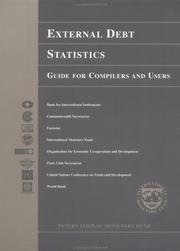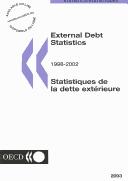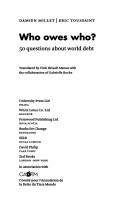| Listing 1 - 10 of 143 | << page >> |
Sort by
|

ISBN: 9789264065161 9781589060609 Year: 2004 Publisher: Washington, D.C. International Monetary Fund
Abstract | Keywords | Export | Availability | Bookmark
 Loading...
Loading...Choose an application
- Reference Manager
- EndNote
- RefWorks (Direct export to RefWorks)
International financial crises in the late 1990s underscored the importance of reliable and timely statistics on external debt as a critical element for the early detection of countries’ external vulnerability. Against this background, improving the quality of key external debt data and promoting convergence of recording practices became of vital importance. External Debt Statistics: Guide for Compilers and Users (the Guide) provides clear guidance on the concepts, definitions, and classifications of gross external debt of the public and private sectors; the sources and techniques for compiling these data, analytical use of these data and the work of international agencies in this field. The Guide was prepared by an Inter-Agency Task Force on Finance Statistics, chaired by the IMF, and involving representatives from the BIS, the Commonwealth Secretariat, the European Central Bank, Eurostat, the IMF, the OECD, the Paris Club Secretariat, UNCTAD, and the World Bank. The preparation of the Guide was based on the broad range of experience of these organizations, in close consultation with national compilers of external debt, balance of payments, and international investment position statistics. The Guide updates the previous international guidance on external debt statistics, External Debt: Definition, Statistical Coverage and Methodology, which was published in 1988, to take account of developments in the 1990s which included new international statistical guidance for national accounts and balance of payments statistics; a substantial growth in private sector financial flows, especially to private sector debtors; and, associated with these, an increased use of instruments such as debt securities and financial derivatives to manage and redistribute risks. The Guide is intended to be a useful source of reference to both compilers and users of external debt data. The core of the Guide’s conceptual framework is the definition of gross external debt (and related terms) and an explanation of the accounting principles required for its measurement. The framework also provides a number of tables for the presentation of the external debt position. The key summary table gives a breakdown of institutional sector of the debtor, maturity and instrument, consistent with national accounts and balance of payments presentations. In addition, several other tables are provided to show important items which facilitate the analysis of the implications of the external debt position, for example, with regard to external vulnerability. These include public and publicly guaranteed external debt, external debt on remaining maturity and ultimate risk bases and foreign currency debt. OECD has a long record of experience in the field of external debt, and its annual publication External Debt Statistics has appeared since the early 1980s. The work has involved close collaboration with its partners, the BIS, IMF and World Bank, in the areas of data exchange and development of methodology and guidelines. OECD has co-authored with these same partners External Debt: Definition, Statistical Coverage and Methodology, 1988, Debt Stocks, Debt Flows and the Balance of Payments, 1994 and the quarterly internet publication, the Joint BIS-IMF-OECD-World Bank statistics on external debt. Sales information, and a pdf version of the Guide may be found at http://www.imf.org/external/pubs/ft/eds/Eng/Guide/index.htm. For further information please contact Deborah Guz, Head of the external debt unit, National Accounts and Economic Statistics of the Division, Statistics Directorate e-mail: deborah.guz@oecd.org

ISBN: 0821350730 Year: 2004 Publisher: Washington, D.C. World Bank
Abstract | Keywords | Export | Availability | Bookmark
 Loading...
Loading...Choose an application
- Reference Manager
- EndNote
- RefWorks (Direct export to RefWorks)

ISBN: 9789264106222 9789264106215 Year: 2004 Publisher: Paris OECD
Abstract | Keywords | Export | Availability | Bookmark
 Loading...
Loading...Choose an application
- Reference Manager
- EndNote
- RefWorks (Direct export to RefWorks)
This annual report presents comprehensive statistics on the gross external debt of 171 developing countries and countries in transition. The 2003 edition has been enhanced with additional series providing more detailed breakdowns of categories of debt and time series data going back to end 1998. These figures are compiled by the OECD, largely on the basis of creditor sources. All figures are shown in US dollars. The External Debt Statistics database is included in OECD's International Development Statistics CD-ROM, and is available on line via www.OECD-iLibrary.org
Public debt --- International finance --- Developing countries

ISBN: 0821350730 9786610084678 1280084677 1417505451 Year: 2004 Publisher: Washington D.C. : World Bank,
Abstract | Keywords | Export | Availability | Bookmark
 Loading...
Loading...Choose an application
- Reference Manager
- EndNote
- RefWorks (Direct export to RefWorks)
Public debt --- Organization theory --- Debts, Public --- Management. --- Debts, Government --- Government debts --- National debts --- Public debts --- Sovereign debt --- Debt --- Bonds --- Deficit financing

ISBN: 1842774263 1842774271 1552661512 8182910013 9832535425 1848138024 9786611259327 1281259322 1848131747 Year: 2004 Publisher: London Zed
Abstract | Keywords | Export | Availability | Bookmark
 Loading...
Loading...Choose an application
- Reference Manager
- EndNote
- RefWorks (Direct export to RefWorks)
International economic relations --- Public debt --- Developing countries --- Debt relief --- Debts, External --- Social Sciences and Humanities. Economics --- Economic Conditions, Development and Structure --- Economic conditions --- Economic policy. --- Economic Conditions, Development and Structure.

ISBN: 1280169494 9786610169498 9264015736 9264015728 Year: 2004 Publisher: Paris, Cedex, France : OECD,
Abstract | Keywords | Export | Availability | Bookmark
 Loading...
Loading...Choose an application
- Reference Manager
- EndNote
- RefWorks (Direct export to RefWorks)
Governments are amongst the major issuers of debt instruments in the global financial market. The present volume provides quantitative information on central government debt instruments for the 30 OECD Member countries to meet the analytical requirements of users such as policy makers, debt management experts and market analysts.
Debts, Public -- OECD countries -- Statistics -- Periodicals. --- Debts, Public -- OECD countries -- Statistics. --- Debts, Public -- Statistics -- Periodicals. --- Debts, Public -- Statistics. --- Debts, Public. --- Debts. --- Debts, Government --- Government debts --- National debts --- Public debt --- Public debts --- Sovereign debt --- Debt --- Bonds --- Deficit financing
Book
ISBN: 146233122X 1452755507 1280884894 1451882912 9786613726209 Year: 2004 Publisher: Washington, D.C. : International Monetary Fund,
Abstract | Keywords | Export | Availability | Bookmark
 Loading...
Loading...Choose an application
- Reference Manager
- EndNote
- RefWorks (Direct export to RefWorks)
This report of the Debt Sustainability Analysis (DSA) indicates that the envisaged strategy of a partial substitution of domestic debt by increased inflows of external grants and concessional loans, as well as a rescheduling of external debt by the Paris and London Clubs, would facilitate the achievement of debt sustainability. The DSA also confirms that such a debt rescheduling could constitute an appropriate exit strategy for Kenya. The DSA also shows that debt sustainability would improve significantly with a concessional rescheduling, particularly under the Naples terms.
Exports and Imports --- Public Finance --- International Lending and Debt Problems --- Debt --- Debt Management --- Sovereign Debt --- International economics --- Public finance & taxation --- Public debt --- External debt --- Debt service --- Debt service ratios --- Arrears --- Debts, External --- Debts, Public --- Kenya
Book
ISBN: 1462329691 1452702780 1282041118 1451902662 9786613797094 Year: 2004 Publisher: Washington, D.C. : International Monetary Fund,
Abstract | Keywords | Export | Availability | Bookmark
 Loading...
Loading...Choose an application
- Reference Manager
- EndNote
- RefWorks (Direct export to RefWorks)
This paper investigates the political and economic determinants of successful fiscal adjustment in 25 emerging market economies from 1980 to 2001. The results show that large and back-loaded fiscal adjustments have the highest likelihood of success. Fiscal consolidations based on expenditure cuts increase the probability of approaching and achieving fiscal sustainability but are insufficient to maintain it unless accompanied by revenue reforms. Adjustment episodes launched in countries where governments enjoy a parliamentary majority and do not face imminent elections, are found to be more successful. Fiscal consolidations undertaken under IMF-supported programs also have a higher probability of success.
Fiscal policy. --- Fiscal policy --- Debts, Public --- Tax policy --- Taxation --- Economic policy --- Finance, Public --- Government policy --- Macroeconomics --- Public Finance --- Duration Analysis --- Fiscal Policies and Behavior of Economic Agents: General --- Fiscal Policy --- Debt --- Debt Management --- Sovereign Debt --- Public finance & taxation --- Fiscal consolidation --- Fiscal stance --- Fiscal sustainability --- Public debt --- Argentina
Book
ISBN: 1462382312 145275229X 1281345431 9786613779007 1451894163 Year: 2004 Publisher: Washington, D.C. : International Monetary Fund,
Abstract | Keywords | Export | Availability | Bookmark
 Loading...
Loading...Choose an application
- Reference Manager
- EndNote
- RefWorks (Direct export to RefWorks)
A striking feature of sovereign lending is that many countries with moderate debt-to-income ratios systematically face higher spreads and more stringent borrowing constraints than others with far higher debt ratios. Earlier research has rationalized the phenomenon in terms of sovereign reputation and countries' distinct credit histories. This paper provides theoretical and empirical evidence to show that differences in underlying macroeconomic volatility are key. While volatility increases the need for international borrowing to help smooth domestic consumption, the ability to borrow is constrained by the higher default risk that volatility engenders.
Debts, External --- Business cycles --- Economic cycles --- Economic fluctuations --- Cycles --- Developing countries --- Economic conditions. --- Exports and Imports --- Macroeconomics --- Public Finance --- International Lending and Debt Problems --- Macroeconomics: Consumption --- Saving --- Wealth --- Debt --- Debt Management --- Sovereign Debt --- Aggregate Factor Income Distribution --- International economics --- Public finance & taxation --- Debt default --- Consumption --- Public debt --- Income --- Debt burden --- Economics --- Debts, Public --- United States
Book
ISBN: 1455278351 1451992726 1280884924 1451880650 9786613726230 Year: 2004 Publisher: Washington, D.C. : International Monetary Fund,
Abstract | Keywords | Export | Availability | Bookmark
 Loading...
Loading...Choose an application
- Reference Manager
- EndNote
- RefWorks (Direct export to RefWorks)
In recent years, the IMF has released a growing number of reports and other documents covering economic and financial developments and trends in member countries. Each report, prepared by a staff team after discussions with government officials, is published at the option of the member country.
Banks and Banking --- Exports and Imports --- Macroeconomics --- Public Finance --- Trade: General --- Aggregate Factor Income Distribution --- National Government Expenditures and Related Policies: General --- Banks --- Depository Institutions --- Micro Finance Institutions --- Mortgages --- Debt --- Debt Management --- Sovereign Debt --- Public finance & taxation --- International economics --- Banking --- Imports --- Income --- Public expenditure review --- Public debt --- International trade --- National accounts --- Expenditure --- Exports --- Expenditures, Public --- Banks and banking --- Debts, Public --- Guinea
| Listing 1 - 10 of 143 | << page >> |
Sort by
|

 Search
Search Feedback
Feedback About UniCat
About UniCat  Help
Help News
News